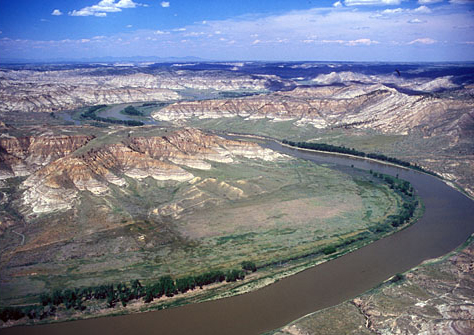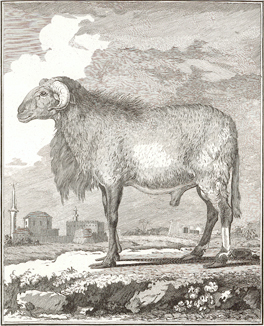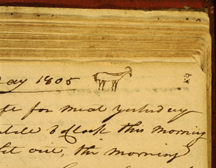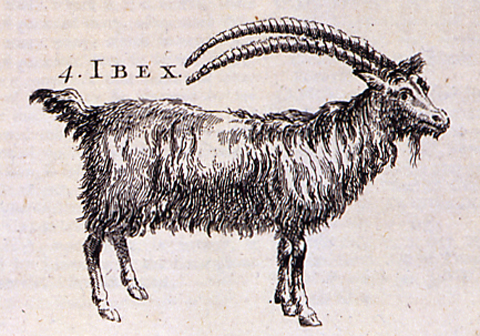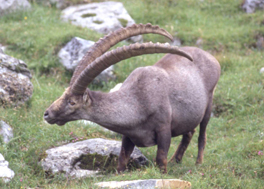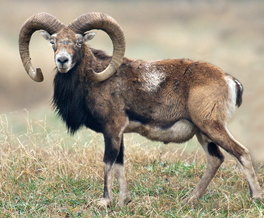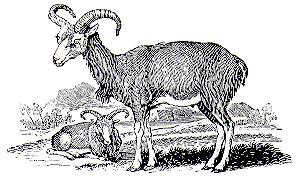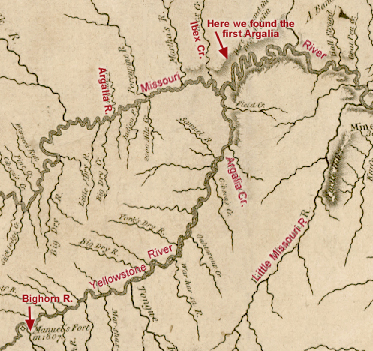Putting ourselves back to 1805, we cannot wonder at the
confusion that arose between these two animals. . . . It was
a sufficiently perplexing case—goats with wool mistaken
for sheep, and sheep without wool mistaken for ibexes.
First Sightings
During a reconnaissance assignment eight miles up the Yellowstone River on 26 April 1805, Joseph Field became the first member of the Corps to glimpse a live bighorn sheep. Considering the region where he was at that time, it probably was a subspecies later named for John James Audubon, but he couldn’t get a shot at it. Three days later, Clark’s party attracted the attention of two bighorns on the cliffs above the river, but failed to shoot either one. “Those animals,” wrote Clark, “run & Skiped about with great ease on this declivity & appeared to prefur it to the leavel bottom or plain.” According to Private Whitehouse, Sacagawea offered some encouraging words, assuring the party that “those animals were very common to be found On the Rocky mountains.”
First Specimen
Argali (pron. ar-guh-lee) are wild sheep that are native to mountainous regions from Siberia southward to the Tibetan Himalayas, and from Afghanistan eastward to the Mongolian plateau. They possess the recurved horns and the deep torso that are characteristic of Ovis canadensis. In the early 1960s zoologists discovered fossil evidence from which they deduced that Ovis ammon of Asia was very likely the Pleistocene ancestral species of Ovis canadensis canadensis, O. c. auduboni (Audubon’s sheep), and Ovis dalli (Dall sheep) of North America.
Judging from the cartoon-like character of both pictures (Figs. 10, 11), but especially that of the ibex, it appears likely that Georges Buffon‘s artist-engraver had not seen either of them in the flesh.
It was a chilly 42° Fahrenheit at sunrise, but the day heated up to 82° by 4:00 p.m. The “high broken and rockey” landscape, as Meriwether Lewis called it, resulted when the old Missouri River, which originally flowed down the present Milk River valley near the Canadian border, was diverted by glacial ice and had to cut a new course through the much older bed of a dried-up inland sea. Lewis didn’t know that, but he could admire the stratification the ancient river had uncovered. The term stratification was then new to the emerging science of geology, and Lewis correctly distinguished the reddish-brown layers of sandstone over the gray-white limestone, and the coal, but he misidentified the strata of shale as “hard black rugged grannite.”[2]The pioneering English geologist William Smith (1769-1839) developed his observations of rock layers in the open coal pits where he worked during the 1790s into what he called “The Principle of … Continue reading
The Corps of Discovery was within what is locally known as “the breaks,” an extensive part of the Missouri River segment of the National Wild and Scenic Rivers System, which includes the famous White Cliffs section they would enter five days later. On this day, the going was rough.
The wind being against us, we did not proceed with so much ease or expedition as yesterday, we imployed the toe line principally which the banks favored the uce off; the courant strong particularly arround the points against which the courant happened to set, and at the entrances of the little gullies from the hills, those rivulets having brought down considerable quantities of stone and deposited it at their entrances forming partial barriers to the water of the river to the distance of 40 or 50 feet from the shore, arround these the water run with great violence, and compelled us in some instances to double our force in order to get a perorogue or canoe by them.
Lewis segued to the day’s most important discovery:
as we ascended the river today I saw several gangs of the bighorned Anamals on the face of the steep bluffs and clifts on the Stard. side and sent drewyer to kill one which he accomplished; Capt. Clark and Bratton who were on shore each killed one of these anamals this evening.
The captains finally had in hand their first three specimens of the “rock mountain sheep.” But they couldn’t agree on what to call it. The problem was, there was no other wild animal in North America that would do for comparison, so instead Lewis and Clark respectively likened it to two different European species they had only read of or heard about.
Bighorns were extirpated from the Missouri River Breaks by the mid-1920s, chiefly by subsistence hunters, but were replaced by seed stock from the Sun River range in the 1970s. Wildlife biologists with Montana Fish, Wildlife & Parks believe that, in terms of the carrying capacity of the habitat, the bighorn population in the Breaks is probably about the same as it was when Lewis and Clark came through—between 800 and 900 head in an area encompassing roughly 500 square miles.[3]Ron Stivers and Al Rosgard, Montana Fish, Wildlife & Parks. Personal communications, 2 July 2007.
Early Intelligence
Both Lewis and Clark might have been aware of the animal’s existence well before they arrived in the vicinity of St. Louis in the fall of 1803, but in any case, they very likely heard stories about it during the following winter. In 1795, George Turner, the territorial judge in Kaskaskia (Illinois) mentioned it in a letter to John Evans before the latter set out to the Mandan villages with James Mackay on a commercial mission for the Spanish government. Turner mentioned that Pierre Chouteau, the prominent trader from St. Louis, had told Turner that far up the Missouri he would likely see a new animal “of the size and nearly the colour of the elk, but with much longer hair.” Under the hair, according to the report, “he is clothed with a fine and very long fur.” Above all, the animal had “two large horns—which, issuing from behind the ears and turning backwards in a circle, terminate in two points projecting before the head, in a horizontal direction.” Furthermore, Judge Turner begged, “do not fail, good Sir, to procure me a couple of the Skins (male and female), so that they can be stuffed to exhibit the entire form and natural attitude of each—I should be glad to receive half a dozen of the horns also.”[4]A. P. Nasatir, Before Lewis and Clark: Documents Illustrating the History of the Missouri 1785-1804, 2 vols. (Lincoln: University of Nebraska Press, 1990), 1:316-17. Neither Evans nor Mackay were able to comply.
The captains encountered their first material evidence of the animal’s existence on 26 September 1804, when Clark saw among the friendly Teton Sioux “a Spoon made of a horn of an animal of the Sheep kind,” big enough to hold two quarts.
Those horns, the captains noticed—coincidentally revealing they had already heard about one of the species’ most conspicuous, though seldom witnessed, social habits—were larger and thicker than those of a domestic ram, “perticelarly that part with which they but[t].”[5]Nicholas Biddle was later to suppose those were the horns of an argali (AR-ga-lee), Ovis ammon, possibly taking his cue from Meehan’s reaction to Patrick Gass‘s opinion. They gained a few more details about the animal from trader Jean Vallé, whom they encountered at the mouth of the Cheyenne River on 1 October 1804. He told them of “a kind of Anamale with large Circuler horns, . . . nearly the Size of an Argalia [or] Small Elk.” Early in the following winter they “precured two horns of the animale the french Call the rock mountain Sheep. . . . The mandans Indians Call this Sheep ar-Sar-ta. it is about the Size of a large Deer, or Small Elk.”[6]Clark, 22 December 1804. “The french” were either French-Canadian traders who frequented the villages, or else the expedition’s own engagés. Argalia is the old spelling of … Continue reading Five more months were to pass before the expedition’s hunters bagged their first specimens.
Lewis’s Description
At last, on the twenty-fifth of May, still many days and miles from the Rockies, Clark himself killed “a female Ibex or big horn animal,” and two of the party’s hunters killed one each. Clark hastily drew a small sketch of the animal at the head of his journal for the day (fig. 4).
Lewis studied the largest ram and produced one of the longest, most detailed zoological descriptions that he ever wrote.[7]The description may have been inserted at Fort Clatsop from field notes. Moulton, Journals, 4:200n. Except for the weight of the head, however, he did not include the specimen’s measurements, which would have been essential to a complete scientific description as well as to any artist charged with creating a drawing of it. In fact, the only hint as to the sizes of the three specimens killed on this date was Whitehouse’s remark that they were “not so large as the Natives [presumably the Mandans] had represented them to us to be.” However, Lewis added some practical uses for the horns that he had thought of, and that would have been of special interest to eastern readers with Enlightenment-based utilitarian values in nature:
The horns are lagest at their base, and occupy the crown of the head almost entirely. they are compressed, bent backwards and lunated; the surface swelling into wavy rings which incircleing the horn continue to succeed each other from the base to the extremity and becoming less elivated and more distant as they recede from the head. the horn for about two thirds of its length is filled with a porus bone which is united with the frontal bone. I obtained the bones of the upper part of the head of this animal at the big bone lick.[8]In his copy of Lewis’s description, Clark added parenthetically, and probably at a later date, that he had seen the same fossil, and found it to be “the Same in every respect with those … Continue reading the horns of the female are small, but are also compress bent backwards and incircled with a succession of wavy rings. the horn is of a light brown colour; when dressed it is almost white extreemly transparent and very elastic. this horn is used by the natives in constructing their bows; I have no doubt but it would [make] eligant and usefull hair combs, and might probably answer as many valuable purposes to civilized man, as it dose to the savages, who form their watercups spoons and platters of it.
the females have already brought forth their young indeed from the size of the young I suppose that they produce them early in March. they have from one to two at a birth. they feed on grass but principally on the arromatic herbs which grow on the clifts and inaccessable hights which they usually frequent. the places they ge[ne]rally celect to lodg is the cranies or c[r]evices of the rocks in the faces of inaccessable precepices, where the wolf nor bear can reach them and where indeed man himself would in many instancies find a similar deficiency; yet these anamals bound from rock to rock and stand apparently in the most careless manner on the sides of precipices of many hundred feet. they are very shye and are quick of both sent and sight.–
More Specimens
Illustration accompanying the article on Ibex in Owen’s Dictionary, which read:
. . . an animal of the goat-kind, with extremely long nodose [knobby] horns, which bend backwards, and are of a blackish colour, and annulated [having ring-like segments] on the surface. The body is of a dark dusky colour, and is less in proportion to the height than that of the common goat; it has a great resemblance to the deer-kind; the legs are also perfectly like those of the deer, straight, elegant, and slender. It is frequent in many parts of Europe, and, notwithstanding its large horns, runs fast and leaps with surprising force and agility.[9]A New and Complete Dictionary of Arts and Sciences, 2nd ed., 8 vols. (London: Printed for W. Owen, 1764). Commonly referred to as “Owen’s,” the expedition’s portable library … Continue reading
En route home, both captains took extra pains to acquire enough complete specimens to take back for further study by qualified cabinet, or laboratory, naturalists. On the 3 August 1806, Clark tried to bag another specimen, but “the Musquetors were So noumerous that [he] could not Shute with any Certainty.” On his command, Private Labiche shot a small ram from the next herd they saw, which Clark directed Private Bratten to “Skin . . . with his head horns & feet [attached?] to the Skin and Save all the bone.” With apparent satisfaction he reported, “I have now the Skin & bone of a Ram a Ewe & a yearlin ram of those big Horn animals.”
Meanwhile, somewhere below the mouth of the Marias River on 29 July 1806, Lewis reported: “On our way today we killed 9 bighorns of which I preserved the skins and skeletons of 2 females and one male.” As they paddled and rowed on down the river at a brisk seven miles per hour, persistent rain threatened to spoil the fresh specimens. Fortunately the sky began to clear late on 1 August 1806, and the rest of the month was mostly sunny and warm. When the two contingents reunited on the twelfth, they had a total of six fine specimens in hand. However, the captains would need to examine them daily to be sure at least one would survive attacks by vermin and bacteria during the nearly three more months it would take them to get back East where qualified naturalists could study them.
Argali or Ibex?
Figure 6
Alpine Ibex, Capra ibex
Photo by Marco Festa-Bianchet, IUCN Caprinae Group, Courtesy GSC/Ovis
A male Capra ibex of the species documented by Carl Linnaeus in 1758 and described in Owen’s in 1764, photographed in the Swiss Alps. An ibex’s body may be from 2.5 to 5.6 feet long, and stand 30 to 34 inches high at the shoulders. A buck’s horns grow up to 40 inches in length. Ewes’ horns are shorter and straighter.
Unfortunately, before the expedition had even begun, George Kearsley Shaw’s definitive taxonomy of the species had already been published, and the captains’ diagnosis was of no apparent value, which may have been the reason that Nicholas Biddle omitted it from the paraphrase that appeared in 1814, and it was lost to science for almost exactly a hundred years after the expedition ended.
Throughout the journals Lewis invariably referred to it as the bighorn but, consistent with his general policy, he did not venture to apply a Latin binomial, nor even to offer any guesses as to the biological lineage of the new species. Clark, however, who usually deferred to Lewis when it came to such questions, briefly considered it to be related either to the argali or the ibex (Fig. 2, 3, 5, 6), but upon seeing one up close he decided it was an “Ibex or big horn animal” simply on the grounds that, as Sgt. Gass quoted him on 25 May 1805, “they resemble that animal more than any other.”
Mouflon?
Linnaeus identified it as Ovis ammon in 1758 (Systema Naturae, 10th ed., 1:70). Argali is its Mongolian name. Ammon was an Egyptian diety usually depicted as having a human body with the head of a ram. The largest of the wild sheep, from 4 to 6 feet long and 3 to 4 feet high, it is native to central Asia as far south as Kazakhstan. It is endangered globally.
It belongs to the new order Cetartiodactyla (molecular evidence having recently revised the makeup of the previous order Artiodactyla), family Bovidae, subfamily Caprinae, and genus Ovis. Like bighorn sheep, the rams butt heads. The mouflon’s chromosomes identify it as a close relative of the domestic sheep, Ovis aries.
The subspecies O. a. musimon is native to Sardinia and Corsica.
Sergeant Gass’s journal appeared in print at Pittsburgh in 1807, less than a year after the expedition’s end. David McKeehan, Gass’s editor and publisher, took issue with Clark’s conclusion. Quoting Oliver Goldsmith[10]Oliver Goldsmith (1728-1774), A History of the Earth, and Animated Nature, 8 vols. (London, 1774); 4 vols. (Philadelphia: Mathew Carey, 1795). The History contained a vast amount of information of … Continue reading, who in turn cited Pierre Bellonius as his authority, he pointed out that the ibex has a large black beard, its brown coat is accented with a black stripe along its back, and the undercoat is light tan rather than white. McKeehan was skeptical. “From what we have before heard of that animal,” he wrote, “and from Mr. Gass’s verbal description, we are led to believe, that it much more nearly resembles the wild sheep, called the Mufflon or Musmon [Fig. 6], to be found in the uncultivated parts of Greece, Sardinia, Corsica, and the desart of Tartary; and which is thought to be the primitive race and the real sheep in its wild and savage state.”
From a twenty-first-century perspective, Clark was partly correct after all, inasmuch as some zoologists are now convinced that ever since their evolutionary origins the bighorn sheep and the ibex have shared certain physical and biological attributes. Moreover, both species favor high, rocky, broken terrain in cold northern latitudes in North America, Europe, and eastern Siberia, and both rely heavily on abundant grazing at lower elevations in summer.[11]Valerius Geist, Mountain Sheep: A Study in Behavior and Evolution (Chicago: University of Chicago Press, 1971), 352-53.
Good Eating
Altogether, the expedition’s hunters killed a total of thirty-five bighorns, mostly for their meat. One of the Corps’ best hunting tales must have been the one about the time Clark’s expert marksmanship trumped a certain bighorn’s mountaineering skill, and the force of gravity delivered a “sweet feast” for a special occasion directly to their campfire. It happened on 1 August 1805 while Clark was in command of the flotilla of dugout canoes making its way through the third “gate” of the Rockies [Jefferson Canyon]. Private Whitehouse recorded the details:
About noon Captain Clark killed a mountain Sheep or Ibex, out of a flock, which were on the sides of Steep reddish hills or Clifts The remainder of the Flock . . . ran up the steep Clifts, out of Gunshot, and to such a heighth as is most incredible– The Mountain sheep that was killed, rolled down the Hill, and we got it.– We stopped at this place to dine, which was amongst the high Clifts, and it being Captain Clarke’s birth day; he ordered some flour to be served out to the party, which with the mountain sheep made us an excellent meal.
Clark’s Map
Wood engraving by Alexander Anderson (1775-1870) for his American edition (1803) of Bewick’s General History of Quadrupeds, originally conceived as a book for young readers. Charitably speaking, one would assume that this cartoonish unlikeness wasn’t intended to elicit any giggles, but we’d bet it did. Anderson also included a wood engraving of “The Wild Sheep of California,” the Rocky Mountain bighorn.
On the map Clark prepared to accompany Nicholas Biddle’s edition of the captains’ journals (fig. 9), he labeled four streams with three different names for the animal. One was among the six southern tributaries of the Yellowstone that the cordial Mandan chief Sheheke had mapped (See Chief Sheheke’s Map) and named for Clark’s information. That was the Ar-sar-ta River, so-called because “there is a variety of wild animals, perticularly the bighorn which is to be found in great numbers on this river.” Clark duly labeled it the Bighorn River, which remains one of the 21 Indian place-names that Clark inscribed on his maps of the region now called the state of Montana.
A second was the “Small river 30 yards wide with Steep banks” that they passed 52 miles above the Yellowstone’s mouth, which Clark first called “Ibex Creek,” but which somehow came to be labeled “Argalia Cr.” on his final map. A third, also named “Ibex Cr.,” was a few miles above the place near the Missouri where Clark and his hunters killed their first specimens. The fourth was another “Argalia R.” (today’s Wolf Creek, entering the Missouri at Wolf Point, Montana) miles upstream from “Porcupine R.” (today’s Poplar River). In addition there was “Ibex Island” (today’s Grand Island) in the Missouri, on which a bighorn was reported killed, although the only mention of that place is in Clark’s list of estimated distances between St. Charles, Missouri and the Pacific Coast.[12]Moulton, Journals, 6:448. (Bighorns, by the way, are very strong swimmers.)
En route home in 1806 the captains accumulated “five skins and skelitons complete of the Bighorn or mountain ram.” Evidently all five of them reached Philadelphia in decent condition, which spoke well for the care in field preservation.[13]Lewis to Jefferson, 23 September 1806. Jackson, Letters, 1:323.
In the spring of 1807 Lewis informed Jefferson that “Mr. Peal is preparing for you the head and horns of the American Argali or big horn.”[14]Lewis to Jefferson, 27 June 1807. Ibid., 2:418. Jackson recounted the ultimate fate of Peale’s mounted specimen. Ibid., 2:734. He also traced the wandering thread of debate over the scientific … Continue reading Peale also exhibited one in his museum.
Jefferson’s Opinion
Thomas Jefferson, who as a plantation owner had become an expert on domestic sheep and had kept up on current discoveries of other breeds worldwide, also participated in the classification debate. He wrote to Charles Willson Peale on 9 October 1805 that he was sending him some specimens, including a pair of horns of “the unknown ram” that Lewis had sent from Fort Mandan. He supposed the animal was a variety of Linnaeus’s Ovis ammon, which the French called by the common name mouflon (Fig. 7, 8). Four months later he wrote to his friend, the philosopher and historian Constantin-François Chasseboeuf, comte de Volney, to report that he had recently received from Captain Lewis “the horns of what is perhaps a species of the Ovis Ammon,” an animal “not before known to the Northern continent of America.”[15]Jefferson to C. F. C. Volney, 11 February 1806. Ibid., 1:291. In a letter to his friend, the French naturalist Bernard Lacépède (1756-1825), written in July of 1808, Jefferson said that along with some fossilized bones Clark had recently dug up for him at Big Bone Lick in Kentucky, he was sending to Lacépède the horns of an animal “called by the natives the Mountain ram, resembling the sheep by his head but more nearly the deer in his other parts.”
Jefferson also sent Lacépède another skin Lewis had brought back, that of an animal:
resembling the sheep by his fleece, but the goat in his other parts. This is called by the natives the fleecy goat, or, in the style of the Natural historian the Pokotragos. I suspect it to be nearly related to the Pacos [alpaca, also of the Andes] and were we to group the fleecy animals together it would stand perhaps with the Vigogna [vicugna, of the Andes], Pacos and Sheep.”[16]The Pokotragos probably was Jefferson’s nonce word. The pacos was the alpaca of South America, a sheep-like camelid with a long neck. The vigogna was the vicugna of the Andes, similarly a … Continue reading Benjamin Smith Barton was interested also. He wrote to Jefferson that he was anxious to see the sheep horns Lewis had shipped back from Fort Mandan. “I doubt not, this will prove to be the Taye of California, described and figured by Venegas, in 1757.[17]Barton to Jefferson, 17 November 1805. Jackson, Letters, 1:271. See also Early Bighorn Specimens, Fig. 3.
Notes
| ↑1 | Elliott Coues, ed., The History of the Lewis and Clark Expedition, by Meriwether Lewis and William Clark, 3 vols. (1893; Reprint, New York: Dover Publications, [1965]), 2:613n. |
|---|---|
| ↑2 | The pioneering English geologist William Smith (1769-1839) developed his observations of rock layers in the open coal pits where he worked during the 1790s into what he called “The Principle of Faunal Succession,” by which the ages of successive strata could be determined from the differences among the fossils they contained. Shale is a sedimentary rock consisting of muds or clays. An excellent introduction to the river corridor today is “The Geology of the Wild and Scenic Upper Missouri,” by Glenn Monahan, at http://www.metnet.state.mt.us/teachMThistory/lessons/uppermissouri.pdf. |
| ↑3 | Ron Stivers and Al Rosgard, Montana Fish, Wildlife & Parks. Personal communications, 2 July 2007. |
| ↑4 | A. P. Nasatir, Before Lewis and Clark: Documents Illustrating the History of the Missouri 1785-1804, 2 vols. (Lincoln: University of Nebraska Press, 1990), 1:316-17. |
| ↑5 | Nicholas Biddle was later to suppose those were the horns of an argali (AR-ga-lee), Ovis ammon, possibly taking his cue from Meehan’s reaction to Patrick Gass‘s opinion. |
| ↑6 | Clark, 22 December 1804. “The french” were either French-Canadian traders who frequented the villages, or else the expedition’s own engagés. Argalia is the old spelling of Argali. |
| ↑7 | The description may have been inserted at Fort Clatsop from field notes. Moulton, Journals, 4:200n. |
| ↑8 | In his copy of Lewis’s description, Clark added parenthetically, and probably at a later date, that he had seen the same fossil, and found it to be “the Same in every respect with those of the Missouri and the Rockey Mountains.” (Both men stopped short of bringing up the mastodon “living fossil” question.) En route down the Ohio in his brand-new barge, Lewis paused at Cincinnati and took a side trip overland to Big Bone Lick, a Pleistocene gathering place where many prehistoric animals, including the ancestors of some modern species, congregated to imbibe the briney water. Occasionally some would become mired in the muck and die, leaving their bones as relics of their time and their species. The fossilized remains of a Pleistocene relative of the Rocky Mountain bighorn has been recovered there, and it may be that Lewis and Clark observed similar relics, though there is no way to be sure. Moulton, Journals, 4:197, 199n. |
| ↑9 | A New and Complete Dictionary of Arts and Sciences, 2nd ed., 8 vols. (London: Printed for W. Owen, 1764). Commonly referred to as “Owen’s,” the expedition’s portable library included a complete set. |
| ↑10 | Oliver Goldsmith (1728-1774), A History of the Earth, and Animated Nature, 8 vols. (London, 1774); 4 vols. (Philadelphia: Mathew Carey, 1795). The History contained a vast amount of information of interest to the general reader at that time, but Goldsmith plagiarized much of it, and not always from accurate sources. An abridged edition was used in American schools for more than twenty years beginning in 1804. Goldsmith is better remembered today for his play, She Stoops to Conquer (1771), his pastoral poem, “The Deserted Village” (1770), and his novel, The Vicar of Wakefield (1766). Pierre Bellonius (1517-1564) had written Les Observations de plusieurs singularitez et choses memorables, trouvées in Grèce, Asie, Judée, Egypte, Arabie— Observations on many singularities and memorable things found in Greece, Asia, Judea, Egypt, Arabia (Paris, 1553)—with particular attention to natural history in those regions. By the time Goldsmith published his History of the Earth, Belonius’s observations were more than 200 years out-of-date. |
| ↑11 | Valerius Geist, Mountain Sheep: A Study in Behavior and Evolution (Chicago: University of Chicago Press, 1971), 352-53. |
| ↑12 | Moulton, Journals, 6:448. |
| ↑13 | Lewis to Jefferson, 23 September 1806. Jackson, Letters, 1:323. |
| ↑14 | Lewis to Jefferson, 27 June 1807. Ibid., 2:418. Jackson recounted the ultimate fate of Peale’s mounted specimen. Ibid., 2:734. He also traced the wandering thread of debate over the scientific identity of the species from 1633 to 1804. Ibid, 1:240-41. |
| ↑15 | Jefferson to C. F. C. Volney, 11 February 1806. Ibid., 1:291. |
| ↑16 | The Pokotragos probably was Jefferson’s nonce word. The pacos was the alpaca of South America, a sheep-like camelid with a long neck. The vigogna was the vicugna of the Andes, similarly a species of the family Camelidae. |
| ↑17 | Barton to Jefferson, 17 November 1805. Jackson, Letters, 1:271. See also Early Bighorn Specimens, Fig. 3. |
Experience the Lewis and Clark Trail
The Lewis and Clark Trail Experience—our sister site at lewisandclark.travel—connects the world to people and places on the Lewis and Clark Trail.
Discover More
- The Lewis and Clark Expedition: Day by Day by Gary E. Moulton (University of Nebraska Press, 2018). The story in prose, 14 May 1804–23 September 1806.
- The Lewis and Clark Journals: An American Epic of Discovery (abridged) by Gary E. Moulton (University of Nebraska Press, 2003). Selected journal excerpts, 14 May 1804–23 September 1806.
- The Lewis and Clark Journals. by Gary E. Moulton (University of Nebraska Press, 1983–2001). The complete story in 13 volumes.
